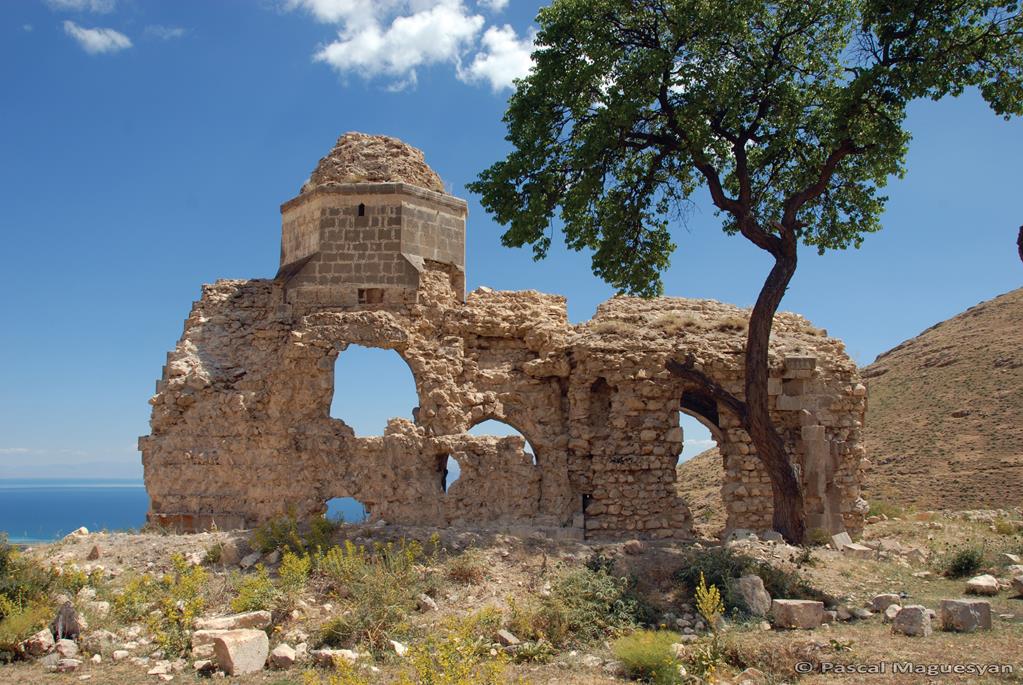The convent of the Miracles stands at an altitude of 2,011 m on a ledge in the southwestern foothills of Mount Sip‘an or Nekh-Massis [Süphan], which, at a height of 4,434 meters towers over the northern shore of Lake Van. The convent is situated at 38° 49’ N and 42° 42’ E, north of the town of Ardzgué [Adilcevaz]. The mountain where it is located is called in Turkish Kilise Dağı, “Church Mountain”.

Église du Saint-Signe Thaumaturge, façade nord, 2012 (Coll. P. Maguesyan).
Formerly known as the Holy Protector (Sourp Erashkhavor), and also Ardzgué Monastery, the convent of the Miracles owes its name to one if its three dedications: the Holy Sign of the Miracles or the Healing Holy Sign (Sk‘anchélakordz Sourp Nëchan), sometimes also called the Holy Sign of War (Badérazmi Sourp Nëchan); the two other dedications invoke Holy Zion and the Holy Mother of God “Mother of Light” (see n° 9). The monastery once also boasted possession of a piece of a miraculous tub in which the infant Jesus had been bathed. According to two ancient colophons, it was already founded in the 9th century. In 1205 the monastic community attempted to collect sufficient funds to ransom a valuable manuscript held in the neighboring town of Khlat‘ [Ahlat] by a cadi of Papert [Bayburt]; the ransom was eventually paid by another community, that of the monastery of the Holy Apostles of Moush [Muş] (n° 54). The manuscript was the famous so-called “Moush” collection of homilies, compiled in 1201 on Mount Sebouh [Köhnem] at Avak Vank‘ (n° 44). From the 14th to the 17th century, the convent of the Miracles was repeatedly mentioned as a scriptorium. It was the seat of the bishop of Pznounik‘. The poet, James (Hagop) Nedrarents († 1501), who joined the convent community in the early 1460s in the last days of its prior Menas (Minas), was one of its great abbots. He praised the sanctuary of Ardzgué in these terms: “Marvelous Holy Sign, honored Sign/ Sign adorned with the glory of the Eternal/ The Evil Spirit’s powers you break / And human ills you disperse”. The convent became the seat of the archbishop at the end of the 16th century. In the 17th century, the church and its narthex were certainly renovated or rebuilt by the archbishop, Simeon, perhaps following the earthquake of 1648. Like many other Armenian establishments, the convent of the Miracles was plundered and burned in 1896. It would be restored by the monk Eghiché upon the decision in 1902 of the diocesan council of Van. The last superior of the convent of the Miracles at Ardzgué was Father Magar, ***

Section and plan (Thierry, 1989, 209)
The convent included: the church of the Healing Holy Sign, an inscribed cross between two free standing columns, with an octagonal drum topped by a pyramid, reconstructed in the 17th century; extending the church due west, an earlier narthex with a pointed barrel vault on lateral arches, restored at the same time and forming with the church a single block 15.3 × 7.1 m; a walled precinct and common buildings. The convent also owned numerous properties.
Confiscated after the Great War, the Convent of the Miracles was left empty. In the 1960s, all that could be seen of the precinct were a few traces on either side of the chevet; all of the commons had disappeared. The church and narthex, already damaged at this time, are today a mere cement skeleton with gaping holes where the covering slabs have been removed. On this frail support sits the remaining half of the drum.

General plan : restitution
Akinian, 1922-1964, IV [1938], 119-139. Oskian, 1940-1947, II [1942], 444-453. Thierry, 1989, 206-212.